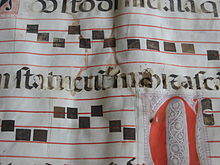- Iron gall ink
-
Iron gall ink (also known as iron gall nut ink or oak gall ink) is a purple-black or brown-black ink made from iron salts and tannic acids from vegetable sources. It was the standard writing and drawing ink in Europe, from about the 12th century to the 19th century, and remained in use well into the 20th century.
Contents
Preparation and use
 Homemade ink. On left, solution of iron (from nails) and vinegar. On right, oak extraction. The two are mixed immediately prior to use to produce the ink, center.
Homemade ink. On left, solution of iron (from nails) and vinegar. On right, oak extraction. The two are mixed immediately prior to use to produce the ink, center.
The ink was generally prepared by adding some ferrous sulfate (FeSO4) to a solution of gallotannic acid, but any iron ion donor can be used. The gallotannic acid was usually extracted from oak galls (also known as "oak apples" or more correctly Oak marble galls), or galls of other trees; hence the name. Fermentation or hydrolysis of the extract releases gallic acid, which yields a darker black ink. The fermented extract is combined with the ferrous sulfate and a binder such as gum arabic.
After filtering, the resulting pale-gray solution had a binder added to it, (most commonly gum arabic) and was used to write on paper or vellum. A well-prepared ink would gradually darken to an intense purplish black. The resulting marks would adhere firmly to the vellum or parchment, and (unlike india ink or other formulas) could not be erased by rubbing or washing — only by actually scraping off a thin layer of the writing surface.
Chemistry
The gradual darkening of the ink was due to the oxidation of the iron ions from ferrous (Fe2+) to ferric (Fe3+) state by atmospheric oxygen. (For that reason, the liquid ink had to be stored in a well-stoppered bottle, and often became unusable after a time.) The ferric ions reacted with the tannic acid or some derived compound (possibly gallic acid or pyrogallol) to form a polymeric organometallic compound[citation needed]. The specifics of chemistry of iron gall ink can be found at About.com
While a very effective ink, the formula was less than ideal. Iron gall ink is acidic ranging from roughly equivalent to a lemon to that of a cup of coffee. For this reason some makers of iron gall ink used crushed egg shells (which contain calcium carbonate (CaCO3)) to temper the ink, bringing it closer to a neutral pH value. Depending on the writing surface being used iron gall ink can have unsightly "ghost writing" on the obverse face of the writing surface (most commonly vellum or paper.) Also any excess of ferrous ions remaining in the ink, over years, decades and centuries, could create a rusty halo around the marks and ultimately it might eat holes through the surface it was on.
Paper has its own special problems with iron gall ink. The iron-tannic pigment did not make chemical bonds with the cellulose fibers. The ink stuck firmly to the paper, but largely by mechanical bonding — namely, the dried ink penetrated the spaces between the fibers and, after drying, became entangled in them. The process of decaying the writing surface is accelerated on paper when compared to vellum, doing the damage in decades or years that could take more than a millennium on vellum.
The acidity of iron gall ink is well known but it must also be observed that the case for the acidity of iron gall ink is somewhat overstated. There are several thousands of manuscripts, some of them well over 1,000 years old, with iron gall ink on them that have no damage or degradation whatsoever from the iron gall ink. This understanding however should not be taken to ignore the potential issues of documents that use iron gall ink for the writing.
Demise
The permanence and water-resistance of the iron and gall-nut formula made it the standard writing ink in Europe for over 1,400 years, and in America after European colonization. Its use and production started to decline only in the 20th century, when other waterproof formulas (better suited for writing on paper) became available. Today, iron gall ink is manufactured and used chiefly by artists enthusiastic about reviving old methods.
Fountain pens
Iron gall ink is not suitable for fountain pens as it will quickly corrode them (a phenomenon known as flash corrosion). Instead, modern surrogate formulas such as blue-black inks by Montblanc and Lamy; Diamine Registrar's Ink, which has a small amount of the ferro gallic compounds; or Rohrer & Klingner "Scabiosa" and "Salix" inks—both of which require the fountain pen to be flushed out regularly with water—are commonly used.
Alternatives
Recently alternative inks that bind with the cellulose in paper, and which have neutral pH, offer superior waterproof, archival and fraud resistant qualities while being less dangerous to pens. Example: Noodler's 'Eternal' inks. [1][2]
See also
- Atramentum
- Indian ink
- Alizarine ink
- Pen and ink
- Ink, especially the section "Writing inks and preservation"
- Oak Marble gall
References
- ^ Noodler’s Ink – the Pilot G2 killer Retrieved 2011-07-06.
- ^ Noodler's Fountain Pen Ink Retrieved 2011-07-06.
Types ballpoint (biro) · demonstrator · digital · dip · fountain · gel · ink brush · light · porous point · qalam · quill · rastrum · reed · rollerball · ruling · skin · stylus · technical (rapidograph)Parts and tools pen inks Related Categories:- Inks
Wikimedia Foundation. 2010.




